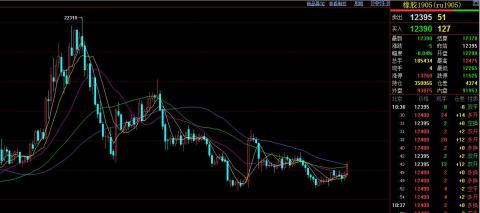On February 19, 2019, the rubber main contract RU1905 rose 5.36%, and continued to rise by nearly 2% the next day, breaking through the important barrier of 12,000 yuan / ton.

Rubber 1905 contract weekly trend
According to the latest report released by the Association of Natural Rubber Producing Countries (ANRPC), in the first 11 months of 2018, global natural rubber production was 12.816 million tons, up 5.4%, while natural rubber demand increased by 5.0% to 12.852 million tons, slightly less than needed. 36,000 tons. From the end of January to the beginning of February each year, parts of Southeast Asia will enter a period of suspension. First of all, China’s Hainan region has been cut off at the end of December of the previous year. The next step is that northern Thailand and northern Vietnam will stop in the end of January to early February. Since mid-February, major rubber-producing areas such as south-central Thailand and southern Vietnam will also be cut, and the amount of rubber produced in Malaysia and Indonesia will also drop sharply, and global glue production will turn into a trough in the whole year. This seasonality of supply shortages continues until the new round of tapping in mid-April.
The following aspects will be the most important factors affecting the rise and fall of rubber in the future;
1. At the end of February in Bangkok, Indonesia, Malaysia, Thailand, the three countries rubber export alliance meeting, Indonesia is expected to propose a plan to reduce rubber export quotas, the target is 300,000 tons, in order to stabilize international rubber price fluctuations, in addition to the international rubber supply side The issue of excess is being negotiated, and it is hoped that the existing export volume will be reduced by 300,000 tons. Indonesia and Malaysia have exchanged views on the reduction of export quotas and have basically agreed to implement the reduction plan. However, the Thai side has not yet expressed its position on whether to join the action plan. In 2018, China’s natural rubber imports reached 2.6 million tons. The main import range is Southeast Asia. If the export volume is limited, it will definitely have a certain impact on China.
2. The National Development and Reform Commission and other 10 departments jointly issued the “Implementation Plan for Further Optimizing Supply and Promoting Stable Growth of Consumption to Promote the Formation of a Strong Domestic Market (2019)”, which was interpreted by the market as a new version of the consumption stimulus policy following the 2009 China’s automobile going to the countryside policy. . As the automotive market sentiment is directly related to tire demand, demand expectations are bound to have a direct impact on the price of domestic rubber. However, we must be alert to the issue of Sino-US trade relations. After the trade war started, the most worrying issue is the import and export of auto parts. At present, the main import and export of Sino-US auto trade is mainly automobile parts. China has about 25% of parts, wheels and tires exported to the United States, while the United States imports parts and components accounted for 7%; therefore, the industry is subject to trade problems. The degree of influence will be further aggravated from chemicals, rubber products and so on. For example, automotive parts tend to decline. In terms of supporting and replacing markets, the inventory growth of the automobile industry is obvious. The pressure to destock in 2018 is relatively large. If there is no corresponding policy support, the domestic market consumption expectation will be greatly reduced.
3. The Thai King’s Election Committee immediately convened a meeting and voted to determine March 24 as the date of the election, which will be the first general election after Thailand’s 2014 coup. We should also pay attention to the corresponding financial subsidies issued by the Thai government, restrict exports and increase demand, and make a deeper interpretation.
For 2019, rubber destocking is still the main task. The domestic and international automobile production and sales prospects are not optimistic. How the results of Sino-US trade dispute resolution will directly affect the future prospects of rubber and some industries. The author believes that in the first half of 2019, the rubber supply and demand situation and the impact of the price of the negative factors are more, always alert to the impact of market prices.
Translated by Google Translator from http://www.cria.org.cn/newsdetail/47721.html




















